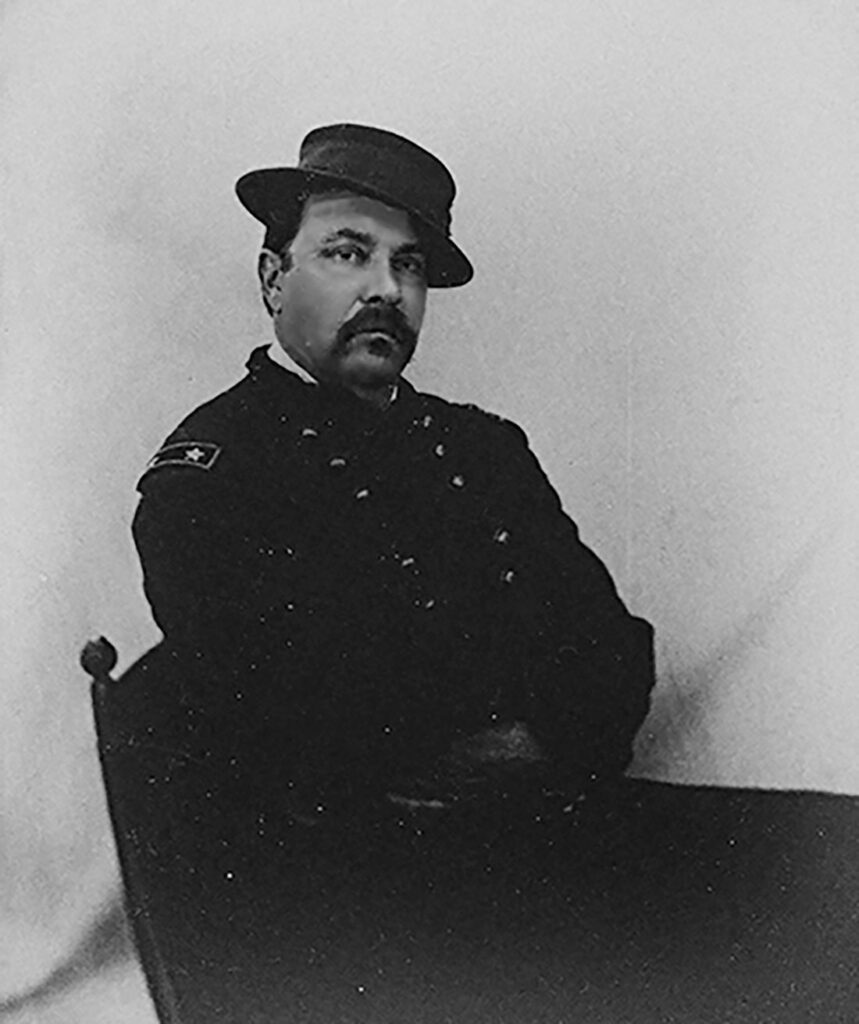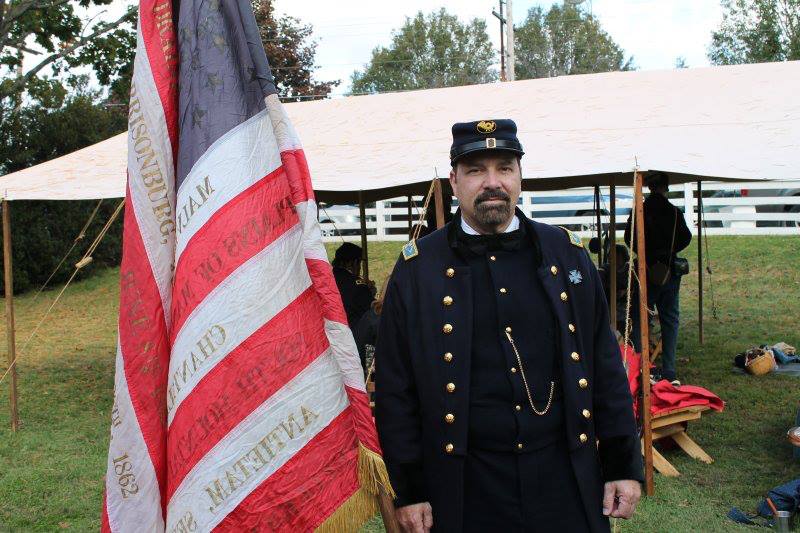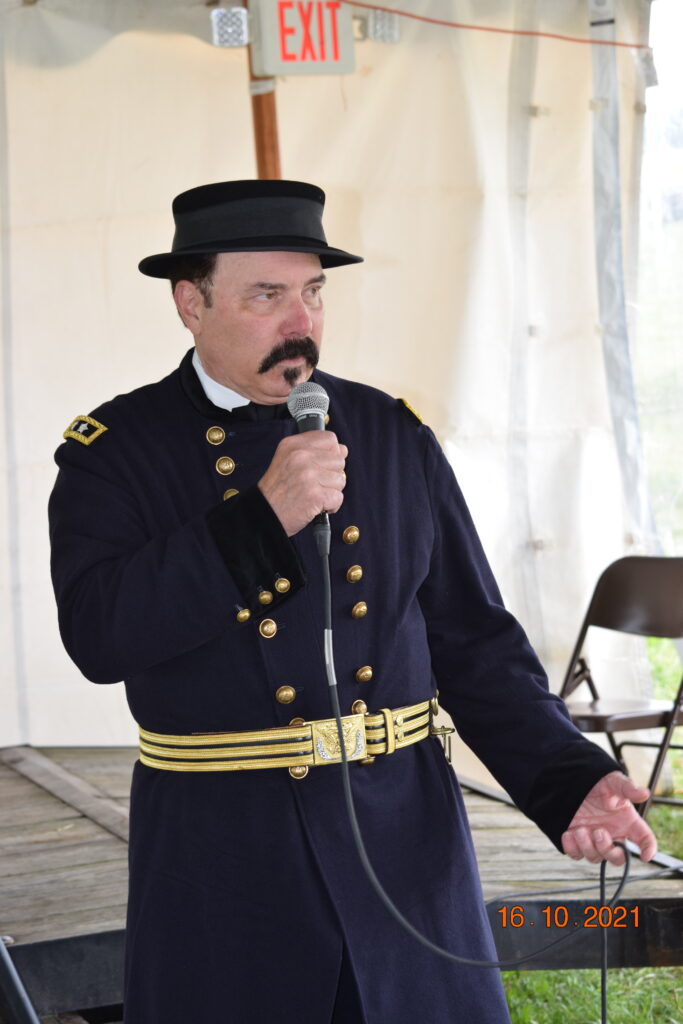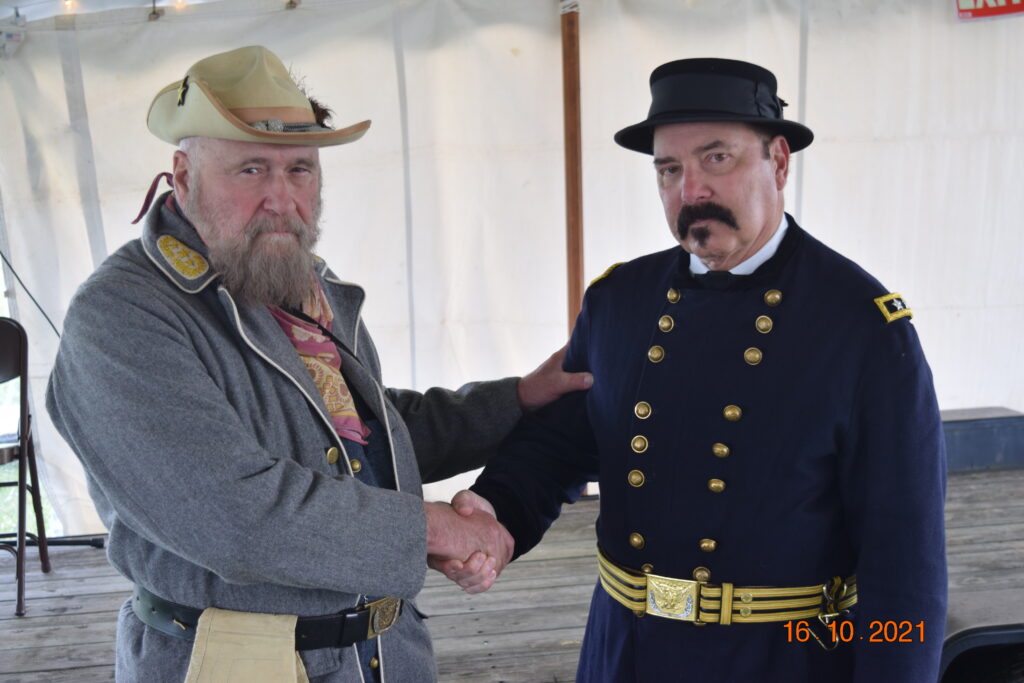Note: Ron Zanoni, who portrays Gen. Sheridan, also portrays for COUG Colonel William McCandless. Ron’s profile of Gen. Sheridan appears below.

Philip Henry Sheridan claimed he was born in Albany, NY on March 6, 1831. He was the third child of six by John and Mary Sheridan of Killinkere, County Cavan, Ireland. Shortly after he was born, his family moved to Somerset, Ohio where he grew up. He went to school there and upon graduating from mandatory schooling he worked as a clerk at several dry goods stores. He was only five feet five inches tall, a stature that led to his nickname, “Little Phil.” Abraham Lincoln described him as “A brown, chunky little chap, with a long body, short legs, not enough neck to hang him, and such long arms that if his ankles itch, he can scratch them without stooping.”
In 1848, he obtained an appointment to the United States Military Academy from a customer, Congressman Thomas Ritchie. In his third year at West Point, he was suspended a year for fighting with a classmate. He graduated in 1853, 34th in his class of 52 cadets.
Upon graduation, he was assigned to the 1st Infantry at Ft.Duncan, TX, and then to the 4th Infantry at Ft. Reading and Ft. Yamhill in the Pacific Northwest. At the outbreak of the Civil War, he was transferred to St. Louis and promoted to Captain in the 13th Infantry under Col. W.T. Sherman. He was then placed as President of a commission to straighten out the books of Major General Henry Halleck’s predecessor, Maj. John Fremont, Commander of the Department of the Missouri. Sheridan performed his task very well and entrenched himself as an excellent officer in Halleck’s view. Halleck then placed him as Chief of the Commissary, but Sheridan convinced him that he should also take on the job as Chief Quartermaster too and reported to Maj. General Samuel Curtis. Not wanting to be a staff officer and looking for action, he petitioned Halleck and ultimately was promoted as Colonel in the 2nd Michigan cavalry. He said, “If I could get into line duty I believe I could do something.”
He fought in a number of Western theater battles. His first was Boonesville, Mississippi where his actions were recognized by Brig. General William Rosecrans who recommended him to be promoted to Brigadier General. He was then assigned to command the 11th Division, III Corps under Maj. General Don Carlos Buell’s Army of the Ohio. He led his Division at the battle of Perryville, Kentucky which led to the Confederate forces abandoning Kentucky. His next battle was the Battle of Stones River where his division held off a Confederate onslaught until they ran out of ammunition. For his actions, he was promoted to Major General of Volunteers. In six months, he had risen from captain to major general.
His division also participated in the Battles of Chickamauga and Chattanooga. During the Battle of Chattanooga, Sheridan’s division and others in George Thomas’ army broke through the Confederate lines at Missionary Ridge.
When General Ulysses S. Grant went east as the general-in-chief of the Union armies, he requested Sheridan to come east to command the Cavalry Corps. His cavalry corps participated in the Overland Campaign with mixed success. His biggest accomplishment was at the Battle of Yellow Tavern which resulted in the mortal wounding of Gen. J.E.B. Stuart. Because of the raids into Maryland and Pennsylvania as well as the threats to Washington, D.C. Sheridan was appointed commander of the Middle Military Division with orders to defeat Jubal Early’s army and close off the Northern invasion route as well as deny the Shenandoah Valley as a productive agricultural region. This destruction presaged the scorched earth tactics of Sherman’s March to the Sea, denying an army base from which to operate and bring the effects of war home to the population supporting it. The residents referred to this destruction as “The Burning” and Sheridan was successful in fulfilling his mission. Upon his return to eastern Virginia, he became instrumental in causing a Confederate breakout of the Petersburg siege at the Battle of Five Forks. His cavalry continued to harass and block the path of the retreating Confederate army leading up to the Confederate surrender at Appomattox.
After the war, he was sent to Texas and Louisiana to assist in the Reconstruction efforts. When asked what he thought of Texas, he replied, “If I owned Hell and Texas, I would rent out Texas and live in Hell.” President Grant appointed Sheridan to head the Department of Missouri in an attempt to pacify the Plains Indians. His department eventually subdued the Indians after the Red River War, the Ute War and the Great Sioux War resulting in the death of Lt. Col. George Armstrong Custer.
In 1869, Sheridan was promoted to Lt. General. In 1871, Sheridan was present in Chicago during the Great Chicago Fire where his leadership assisted in providing security to the city. In 1883, Sheridan succeeded W.T. Sherman as Commanding General of the U.S. Army.
Sheridan, while a proponent of destroying all buffalo as an incentive for Indians to return to their reservations, was instrumental in establishing the Yellowstone National Park.
He married in 1875 at the age of 44 to Irene Rucker, 22. She was the daughter of Quartermaster General Daniel Rucker. They had four children including a set of twin girls. They lived in Washington, D.C. in a house given to them by the Chicago citizens in appreciation of Sheridan’s protection of the city during the Great Fire. Sheridan suffered a number of heart attacks and at 57 years of age, after years of hard living, hard campaigning, love of good food and drink took their toll, he died at his summer cottage in Nonquitt, Massachusetts on August 5, 1888. He is buried in Arlington National Cemetery.
General Philip H. Sheridan was a motivating, daring and courageous leader. General Grant thought highly of Little Phil and said that, “…Sheridan had no superior, living or dead, as the commander of the army.” Sheridan’s military career can be summed up after the Battle of Five Forks. Horace Porter spoke to Sheridan following the battle saying, “It seems to me that you have exposed yourself today in a manner hardly justifiable on the part of a commander of such an important movement.” Sheridan responded, “I have never in my life taken a command into battle and had the slightest desire to come out alive unless I won.”
Ron Zanoni


Always a military history buff, in particular World War Two, I became interested in the American Civil War in 1996 after I was given a book to read entitled, “Killer Angels.” I visited Gettysburg and I developed a thirst for more information on battle there and the those involved. Being an avid photographer, I began visiting the battlefield to photograph it. The American Battlefield Trust noticed my photos and began to publish some of them in their quarterly magazine, “Hallowed Ground.” Sixteen of my photos were used for the 150th Anniversary edition of the magazine.
I studied for the Gettysburg Battlefield Licensed Guide exam and passed the requirements up until I withdrew from the process at the end of the process for family reasons.
After some years of visiting Gettysburg, my wife and I decided to dress in period clothes and walk through the town of Gettysburg. However, I wanted to portray an individual rather than just walk around. After much research, I decided to portray a Colonel from Philadelphia, PA. Colonel William “Buck” McCandless, who commanded the 2nd PA Infantry Reserves, as well as a PA Reserves Brigade in the Fifth Corps. He did this until his three year commitment was terminated in May of 1864.
In 2015, I was asked to portray Major General Philip Sheridan since I had a likeness to the General. I’ve portrayed “Little Phil” at various events such as Gettysburg, Manassas, and Cedar Creek to name a few, as well as the national CWRT Congress and several local Civil War Roundtables.


I’m a retired Corporate Safety and Health Manager who worked in the chemical industry for over forty years. My hobbies are photographing birds-in-flight, floral macros, and landscapes in addition to fishing on my bass boat.
I am a volunteer photographer for the American Battlefield Trust and the Shenandoah Valley Battlefield Foundation. I am a member of the American Battlefield Trust, Shenandoah Valley Battlefield Foundation, Gettysburg Foundation, the General Meade Society, and the Custer Memorial Association.
I live in Sadsburyville, PA with my wife Linda and cat Mae.